Growing champignons at home
Recently, more and more often you can hear conversations about growing mushrooms as one of the forms of gardening and horticulture. Although mushrooms cannot be compared to traditional crops like potatoes or cucumbers, growing them is quite simple. The most popular type of mushroom is the well-known champignons. This is a very good option to start mushrooming. Champignons can be cultivated all year round: in the summer in the garden, and in the winter indoors (in the greenhouse, basement, on the balcony). Growing champignons in large volumes is a very good opportunity for additional income, as well as an opportunity to pamper yourself and loved ones with a fresh delicacy.
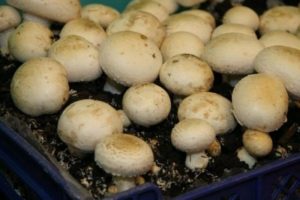
Content
Features of growing champignons at home
Champignons or peppers are the most popular type of mushroom, most commonly consumed all over the world.It's all about the adaptability of the variety to grow in different parts of the world, so no one has problems with their cultivation. Growing champignons at home is considered a very laborious process in terms of preparing and equipping a breeding room. The mushrooms themselves do not require additional care after sowing, and timely watering and temperature conditions will ensure a good harvest.
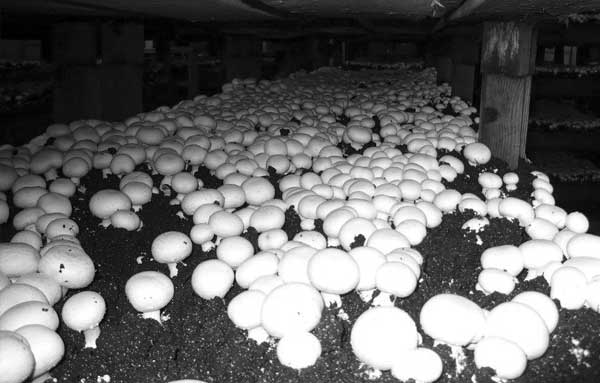
You can grow champignons at home on the windowsill or on the balcony. But if you have an intention to grow mushrooms in large volumes, then you cannot do without preparing a special room. The best option for growing mushrooms will be basements or cellars, where direct rays of daylight do not penetrate, the temperature and humidity of the air are well maintained.
The following equipment should be installed in the room and special conditions created for growing mushrooms:
- Shelving. It is necessary to prepare racks on which future mushrooms will grow. They can be designed with your own hands, or you can purchase ready-made racks. It is best if they are made of plastic or carbon fiber. Since there is a lot of dampness in the basements, metal parts will quickly rust, and the tree will act as a collection of bacteria and parasites that can spoil the crop.
- You can grow mushrooms directly on the shelves by spreading the substrate on them. You can also place the substrate in plastic containers for growing mushrooms. If you want to save money, then as containers you can use ordinary plastic bottles volume of 6 liters.
- Temperature and humidity. Champignons are thermophilic, the average temperature of the environment in which they grow is 16-27 ° C. Therefore, the room must be insulated and heat-resistant. It is best if there is a controlled heating system in the cellar (preferably water). Electronic heaters significantly dry out the air, thereby slowing down the growth of mushrooms. Air humidity can be controlled with electronic humidifiers, but this is a very expensive equipment. It is enough to purchase a garden sprayer and thoroughly irrigate the soil so that it is always moist and does not dry out. Air humidity should be around 70-95%.
- Ventilation. Mushrooms grow exclusively in the fresh air, so the room will have to be systematically ventilated. The ideal solution would be to install special hoods or air conditioning systems.
- Lighting. Champignons love light, but direct rays are contraindicated for them. For this, special lamps of diffused daylight are installed in the room. If the room has access to daylight (windows, transparent roof), there is no need for additional installation of lamps.
Important! Before spreading the substrate and sowing mycelium, the room must be disinfected. To do this, you can use special smoke bombs, which are left in the room for a day, before the start of all planting work. All racks must be treated with a sulfate solution. Mushrooms love moisture, and accordingly the humidity in the room will be increased. In order to avoid the formation of fungus and mold on the walls, it is recommended to cover them with a solution of lime and copper sulfate. This disinfection is necessary so that the fungi do not succumb to the attacks of various parasites.
How to grow champignons at home: growing technology
The amount of harvest depends on the quality of the mycelium and the substrate in which the mushrooms will grow. The basis of a high-quality substrate for mushrooms is horse manure with a high content of straw. But when it comes to growing at home, the substrate for the mushrooms can be prepared differently.
The technology for growing champignons involves several stages.
Substrate preparation
To prepare a substrate for growing mushrooms you will need:
- 100 kg of fresh golden straw (wheat or rye);
- 100 kg of horse (cow) manure or poultry manure;
- 2.5-3.5 kg of urea or ammonium nitrate;
- 250-350 liters of water;
- 7-8 kg of gypsum or alabaster;
- 2 Kg superphosphate;
- 5 kg of chalk.
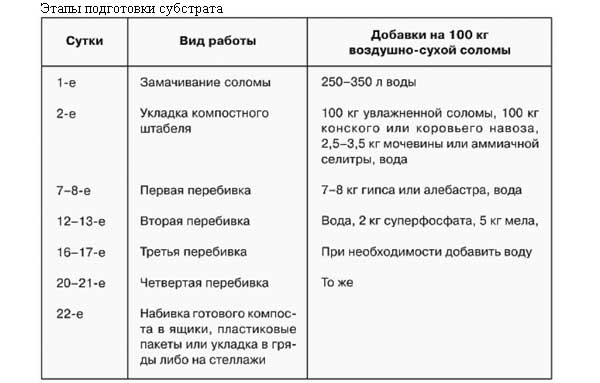
On the first day the straw is cut into a length of 15-20 cm and soaked in water to make it moist.
Further, for the compost to mature on a concrete area, it will be necessary to lay a stack of at least 1.5 x 1.2 m in size.Straw and manure (droppings) are laid out in layers 25-30 cm thick.Urea or ammonium nitrate is added to the mixture in the amount of 2.5 -3.5 kg. The bottom and top layers must be straw. Then the top of the compost is covered with a film, and holes are made on the sides for ventilation.
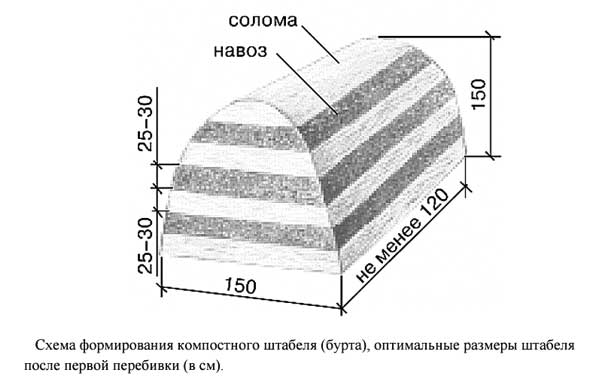
Important! Contact of the mixture with soil or rainwater is extremely undesirable, it is important to avoid penetration of pest spores into the compost.
For the next 21 days, the mixture undergoes a fermentation (combustion) process, during which ammonia, carbon dioxide and water vapor are released, and the temperature in the pile can reach 70 ° C. During this time, you need to kill the compost 3-4 times.
The first interruption is carried out for 7-8 days, also gypsum or alabaster is added to the mixture, as well as a little water.
The second cut is carried out on 12-13 daysadding to the mixture superphosphate (2 kg) and chalk (5 kg), plus water.
The third cut is carried out on 16-17 days, water is added again.
Fourth cut on 20-21 days.
On day 22 the finished compost is packed into boxes or plastic bags.
It is possible to determine the degree of readiness of compost by external signs: high-quality compost has a thick brown color and a loose texture, does not stick to hands and softly springs when squeezed, there is no characteristic sharp ammonia smell.
As a result, about 300 kg of substrate is obtained, which corresponds to 3 square meters of area for growing champignons.
Remember! In preparing the nutrient substrate, it is very important not to overdo it with manure and urea. Clearly calculate the volume of soil you need and the components included in it, otherwise the mycelium may burn out.
Selection and purchasemycelium
In order to grow a high-quality and healthy crop, special attention should be paid to the seed. A good mushroom mycelium is grown exclusively in laboratories, and it can only be purchased in large horticultural centers that cooperate with large laboratories that produce various crops (including mushrooms).
There are two specially designed types of mushroom mycelium intended for growing at home: compost and grain.
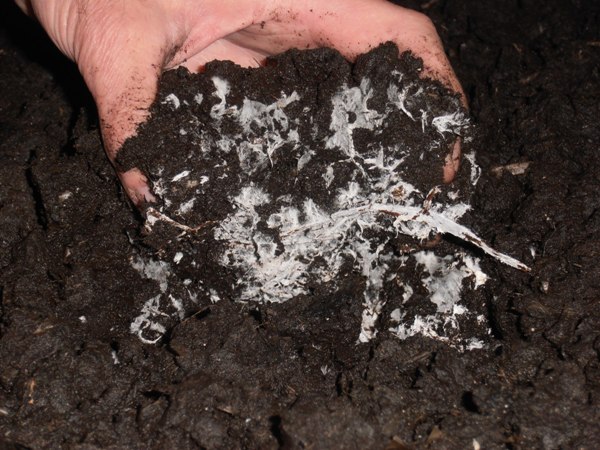
Compost mycelium stored in glass containers at 0 °. The shelf life of such material is one year. It is a high quality eco-friendly material for growing healthy crops.
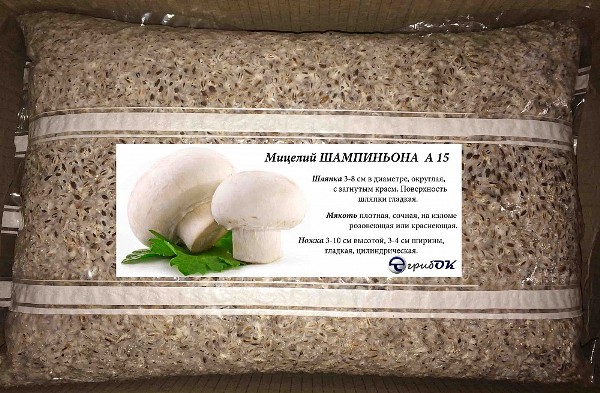
Grain mycelium packed in plastic bags, which reduces its shelf life to 6 months from the date of issue. But it is the grain mycelium that is more fertile and gives a greater yield increase, which significantly increases productivity. It is recommended for beginners to use grain mycelium, as it is more adapted to a changeable environment.
Landing
Before starting planting, the compost undergoes a special heat treatment. It is heated with special lamps, since when sowing, its temperature should be at least 27 ° C. Such a high temperature of the substrate is necessary for a better interaction of spores with fertile soil.
Further, the disembarkation takes place accordingly in the following order:
- Beds are laid out from the heated compost or placed in containers for planting. The soil layer is approximately 30 cm thick.
- In a checkerboard pattern at a distance of about 25 cm, it is necessary to form planting holes, the depth of which is up to 5 cm.
- Mycelium is poured into each well (compost mycelium the size of a tennis ball is placed in each well).If the mycelium is grain, then its inoculation can be carried out by scattering it over the surface and covering it with a thin layer of soil.
- When the mycelium begins to grow, and this will happen in 1-2 weeks, the surface of the substrate must be covered with a casing layer of 3-4 cm.
After disembarkation, it is necessary to carefully monitor the development of myceliums and provide full care.
Care
Champignons, like all mushrooms, are absolutely unpretentious plants. After sowing, they do not need special care. It is enough to follow the simplest growing rules, namely:
- High humidity. The air humidity in the room where the mushroom plantation is concentrated should be at least 65% - 90%. In order to maintain this level of moisture, the beds are covered with garden sacking or ordinary newspapers, which must be irrigated regularly with water. It is important to control that water does not fall on the soil where the formed mycelium is concentrated, as it can rot.
- Temperature conditions. As mentioned above, the temperature of the substrate during planting should be 27 ° C, and accordingly the air temperature in the room should be high (up to 30 ° C). As soon as the first shoots of mushrooms appear (approximately a week after sowing), the temperature can be lowered by 10 degrees, to 17 C ° - 20 C °. It is best to equip the room with water heaters. They consume little electricity and do not dry out the air. Watch the soil constantly so that it does not dry out. The indoor climate should resemble a greenhouse.
- Fertilizer. As it grows, the mycelium gradually comes to the surface, and after two weeks, it will be completely above the soil. To avoid drying out and to prevent the destruction of the still fertile mycelium, a little fertile substrate is poured upward (about 4 - 5 cm). Fertilizer is also applied to the soil, which consists of a dry peat mixture and chalk in proportions of 9: 1. Spread 40-50 grams of the mixture on 1 m² evenly. A week after the fertilization, the room temperature is lowered by another 5 ° C to 13 ° - 15 ° C. The soil continues to be thoroughly moistened with irrigation systems, while preventing moisture from entering the main soil layer.
- Lighting and ventilation. If there are no windows in the room, the myceliums will have to be illuminated with fluorescent lamps. Mushrooms are illuminated for 5 - 6 hours a day, no longer worth it. Also, the room must be regularly ventilated, because mushrooms grow only in the fresh air. Various ventilation systems can be used for this.
Harvesting
It usually takes about four months from sowing to harvesting the first crop. Suitable for harvesting are young medium-sized mushrooms, which have a whole membrane that connects the stem to the cap. Strongly opened mushroom caps lose all their useful properties, so they are harvested as seed. Picking mushrooms is strictly prohibited, the cap of which has darkened and turned light brown. They can cause intoxication of the body, which leads to severe poisoning.
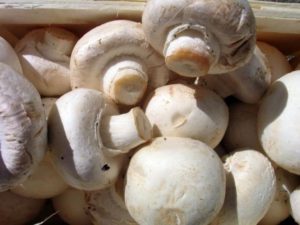
Champignons are not cut, unlike forest mushrooms, they must be twisted, and the hole remaining after their removal is lightly sprinkled with compost. A mushroom will grow in this place again. Mushrooms actively bear fruit for about 8-14 weeks. During this time, up to 7 harvest waves can pass. Further, the yield is very weak, so the myceliums are removed and the substrate is disposed of.
Video: Harvesting Homemade Champignons
It's important to know! After the myceliums have stopped bearing fruit, they are removed and used as a nourishment for the next generation. It is not recommended to reuse the remaining substrate, as it loses all its fertile properties.
For the entire fruiting period, up to 60 kg of fresh mushrooms can be harvested from 1 m². This is a very good result that can be achieved if all the rules of cultivation and care are followed.
Diseases and pests of champignons, the fight against them
The main method of dealing with all diseases and pests, in fact, is the main disinfection of the premises with the help of smoke bombs, whitewashing the walls and spraying. But still, there are times when mushrooms get sick and succumb to attacks from various pests. Here are some of the most common diseases and methods of dealing with them:
- Mushroom midge. If the room is not ventilated enough, fly larvae begin to develop in the compost, which enter it along with the manure. Over time, they affect the mycelium, which ceases to bear fruit and disappears. To eliminate parasites, it is enough to treat the compost with chlorophos with a concentration of 0.5%.
- Mushroom mite. This is a small yellow parasite that eats the legs of mushrooms. To eliminate them, mushrooms and compost are sprayed with a 0.1% metaphos solution. To avoid this problem in advance, you can add tobacco to the substrate. Enough 0.5 kg of tobacco per 100 kg of substrate.
- Rotting mushrooms. The disease develops with direct penetration of moisture into an already formed mycelium. From a diseased fungus, others instantly become infected. To avoid the rapid spread of the disease, the damaged myceliums must be removed, and the remaining ones must be treated with a 0.2% formalin solution.
- Mummies. This disease, which occurs as a result of a lack of light, mushrooms acquire a dark gray cap and brown flesh. It is enough just to remove such mycelium along with the substrate.
- Mold on mushrooms. The disease manifests itself as the formation of wet brown spots on the surface of the fungi, which increase in size. All infected mushrooms should be removed.
Growing champignons at home is not difficult, but rather laborious process that requires a lot of time and patience. Home growing will provide an opportunity not only to get year-round access to delicious mushrooms, but it may well become a source of good income. A person with minimal gardening experience will be able to cope with such a task, because growing mushrooms does not require any special knowledge.
Video: growing champignons at home

